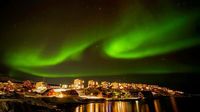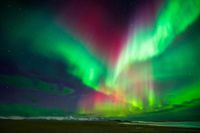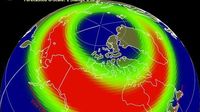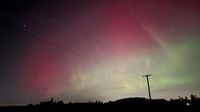Excitement is building for skywatchers across the northern U.S. as the aurora borealis could light up the skies as far south as parts of 15 states. A surge in solar activity has led NOAA to forecast geomagnetic storms that will bring the northern lights to unexpected locations this weekend. This extraordinary phenomenon, as reported by Forbes, is expected to be visible as far south as regions in Washington, Minnesota, and even parts of New York and Maine.
When and Where Will the Northern Lights Be Visible?
The aurora borealis is often seen in the northernmost regions of the Earth, but this week, a powerful geomagnetic storm is expected to make its way down from the poles, allowing viewers across northern U.S. states to catch a rare glimpse. According to NOAA, this stunning light show will be visible across parts of Alaska and Canada, with spots across the U.S. in places like North Dakota, Upper Michigan, and Montana seeing a higher likelihood of sightings. Regions in Wyoming, South Dakota, Iowa, and New England may also get a rare chance to catch the lights, though the activity will be less intense the further south you go. For many, this is a rare opportunity to witness one of nature’s most beautiful spectacles without needing to venture all the way to the Arctic.
The aurora is expected to be particularly visible on Friday night between 10 p.m. and 2 a.m. local time, when skies are darkest and conditions are ideal for viewing.
What Are Geomagnetic Storms and Why Do They Cause the Northern Lights?
You might be wondering, what exactly triggers these dazzling light shows in the sky? The northern lights, also known as the aurora borealis, are caused by solar events—such as solar flares and coronal mass ejections—which release charged particles that interact with the Earth’s magnetic field. This interaction causes the particles to excite gases in the Earth’s atmosphere, producing the bright, colorful displays of light. A coronal hole on the sun’s surface is expected to send these particles toward Earth, creating the perfect conditions for geomagnetic storms.
As we’re experiencing a period of heightened solar activity, known as the solar maximum, the intensity and frequency of geomagnetic storms are increasing. This has resulted in stronger auroral displays that may reach as far south as regions that typically don’t see the northern lights. The next few years, including 2025, will likely provide skywatchers with even more opportunities to witness these breathtaking events.
How to Make the Most of Your Northern Lights Experience
While the idea of catching a glimpse of the aurora borealis may sound exciting, the experience is all about timing and location. NOAA recommends finding a high vantage point away from the distractions of city lights. As light pollution can obscure the view, it’s essential to find dark, open areas where the display will be most visible. The best time to view the northern lights is typically between 10 p.m. and 2 a.m., when the sky is at its darkest.
For those looking to capture the event through photography, experts suggest using a wide-angle lens with a low aperture, ideally f/4 or lower. For smartphone users, night mode should be enabled, and the flash should be turned off for the best possible results. Don’t forget to bundle up, as the best views are often found in chilly, crisp air!
Why Is This Solar Activity Special?
As mentioned earlier, the solar maximum plays a significant role in the current surge of auroral activity. NASA has reported that the last solar cycle reached a 500-year peak in 2024, meaning we’re currently in the midst of an extraordinary period for aurora sightings. This peak, which is expected to persist through 2026, is giving rise to geomagnetic storms that are stronger and more frequent than usual. Interestingly, the most powerful geomagnetic storm in recent memory occurred in May 2024, bringing the northern lights to locations as far south as Florida and Texas—something rarely seen outside the higher latitudes. This further highlights the intense solar activity and its lasting impact on Earth’s magnetic field.
Topline A spot on the sun’s surface is expected to disrupt Earth’s magnetic field on Friday, bringing the northern lights to a selection of states along the Canadian border, according to the National Oceanic and Atmospheric Administration. A spot on the sun’s surface will likely disrupt the Earth’s magnetic field, forecasters said.
Key Facts NOAA forecast a Kp index of five on a scale of nine for Friday night, indicating the northern lights will move farther from the poles and be “quite pleasing to look at” for those in the right areas. Increased auroral activity will likely result from geomagnetic storms Friday and Saturday amid “influence” from a coronal hole, or a cooler, less dense spot on the sun’s surface that disrupts Earth’s magnetic field, according to NOAA’s three-day forecast.
The northern lights are expected not to be as visible Saturday and Sunday, with a maximum Kp index of three forecast for either day.
Where Will The Northern Lights Be Visible?
The highest chance of viewing the northern lights is forecast across northern Canada and Alaska, while areas in Washington, northern Idaho, Montana, North Dakota, Minnesota, Upper Michigan and Wisconsin have a lower chance. Parts of Wyoming, South Dakota, northern Iowa, New York, Vermont, New Hampshire and Maine have an even lower likelihood of seeing the phenomenon.
What’s The Best Way To See The Northern Lights?
NOAA recommends traveling to a high vantage point away from light pollution, as the northern lights are best seen between 10 p.m. and 2 a.m. local time.
What’s The Best Way To Photograph The Northern Lights?
Photography experts told National Geographic that a camera with a wide-angle lens, F-stop or aperture of four or less and focus set to the furthest possible setting is best for capturing the northern lights. If using a smartphone, NOAA recommends turning on night mode and disabling flash.
Key Background Aurora borealis is the result of electrons from solar events like solar flares and coronal mass ejections interacting with oxygen and nitrogen in Earth’s atmosphere. This intersection causes these electrons to become “excited” and release the colorful displays of the northern lights. A peak in solar events was achieved in October 2024, according to NASA, amid what the agency said was a 500-year peak for northern lights displays. This peak, a “solar maximum,” will likely persist into early 2026, NASA said. The strongest geomagnetic storm in the last two decades disrupted Earth’s magnetic field in May 2024, bringing the northern lights as far south as northern Florida and Texas.




